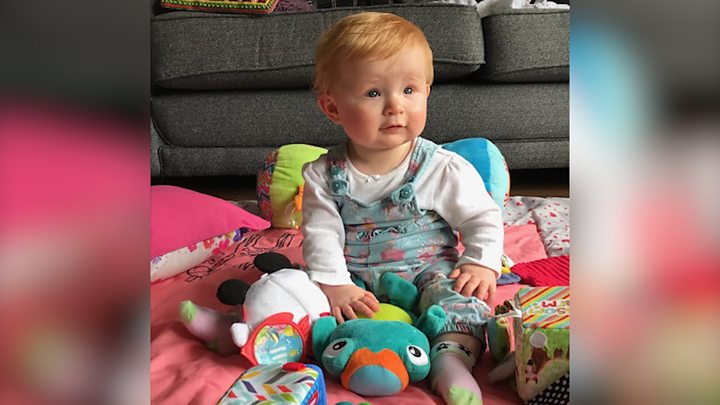Heidi died just a few days after becoming ill with a high temperature
New monitors that can detect the deadly blood condition sepsis are being fitted at a Scottish children’s hospital.
The equipment will be installed at the Royal Hospital for Children in Glasgow.
Charlotte Cooper, who lost her nine-month-old daughter Heidi to sepsis last year, said she had “no doubt” the monitors would help save babies’ lives.
She told BBC Scotland: “You don’t have time to come to terms with the fact that someone you love is dying from sepsis because it happens so quickly.”
Ms Cooper, 40, now wants to see the monitors installed in every paediatric ward in Scotland.
“We need to do whatever we can to stop preventable deaths from sepsis in Scotland,” she said.
The funding for the machines in Glasgow came from the charity Sepsis Research Scotland following a donation from Spifox – the Scottish property industry’s charity which raises money for children and young people.
The monitors record and track changes in heart rate, temperature and blood pressure – and can pick up early sepsis symptoms.
Sepsis is the body’s life-threatening overreaction to an infection and can be hard to diagnose.
Ms Cooper, from Airdrie, said Heidi had become ill very quickly after a Monday trip to the zoo in July.
“She was a very strong, healthy, happy baby. She completed our family, we had waited a long time to have her,” she said.

Media playback is unsupported on your device
Heidi was seen by a GP after getting a high temperature and becoming “very lethargic” and she was referred to Wishaw Hospital.
Ms Cooper said she initially thought that Heidi was teething. She was given Calpol and fluids and was a “bit perkier” when she woke up the following morning.
However, by the afternoon her fever had returned.
Ms Cooper said: “Wednesday morning she was in the kitchen in her high chair. She wasn’t as bright and bubbly as usual but she was sitting up eating by herself.
“The rest of Wednesday she deteriorated. Her fever went up and it went down. She was pale sometimes.
“She was lifeless like a wee doll for most of Wednesday afternoon. She was sitting in her chair, sleeping on and off.”
She returned to the hospital and Heidi began projectile vomiting and had a very high temperature. Doctors assessed her and she was admitted at 00:30.
Ms Cooper said sepsis was mentioned later that morning.
Image copyright
Charlotte Cooper
Heidi died just a few days after becoming ill with a high temperature
“I’d heard the word but I did not really know what the signs or symptoms were at all,” she said.
“One minute you are told your baby is very sick and the next minute she has gone. It’s so fast. The aftermath is one of disbelief, shock and struggling to understand how something like this can happen.”
Ms Cooper said she hoped Heidi’s story would raise awareness of a condition which is often difficult to diagnose.
“If her story can save a life, I will be so proud.”
She also believes the new machines will help prevent further deaths.
“It eliminates the uncertainty of a doctor and Heidi saw so many different doctors. A monitor is always there. It’s going to make a huge difference. It is a fantastic first step in Scotland,” she said.
The machines, which have been installed in a critical care area, use a measuring system called Paediatric Early Warning Scores to monitor the children for any signs of deterioration in their condition.
Sepsis Research said early warning of the changes would mean sepsis being diagnosed and treated faster.
The monitors were accepted on behalf of the hospital by senior staff nurse Sharon Pate, who said: “In a very busy paediatric word it is vital all our patients are monitored regularly and closely for signs of deterioration.
“The addition of these new monitors will greatly improve our ability to monitor patients and provide vital care.”
What are the symptoms of sepsis?
In children:
- a mottled, bluish or pale appearance
- very lethargic or difficult to wake
- abnormally cold to touch
- breathing very fast
- a rash that does not fade when you press it
- a seizure or convulsion
In adults:
- slurred speech
- extreme shivering or muscle pain
- passing no urine in a day
- severe breathlessness
- high heart rate and high or low body temperature
- skin mottled or discoloured.
